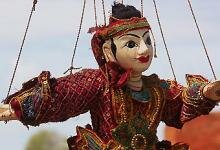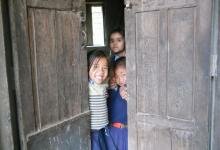Proud Puppets and Whizzing Wizards
Politics, propaganda, “post-modernism” and amid it all, the search for truth – a look at the trials and triumphs of modern Burmese poetry

When the BBC asked me in a recent interview what books the youth in Burma today are reading, I told them our boys and girls are too busy looking for means of survival to bother about literature. The interviewer retorted that someone in a Rangoon bookshop had told her they do read computer books and economics books. I told her such books are not literature, at least not imaginative literature. The young people today are not reading the kinds of books we used to read in our student days – books by Shwe-udaung or Bhamo Tin Aung, novels by D.H. Lawrence or George Orwell, or the Rubaiyat of Omar Khayyam or Mayakovskiy's Cloud in Trousers.
This is the state of affairs in our country's literature today. In a country of about fifty-two million, if a novel sells about three thousand copies, we call it a best-seller. If a book of poetry sells five hundred copies, it is a hit. A magazine is said to be doing fine if two thousand copies are sold out each month. Most of them are happy to have a monthly circulation of six hundred. But on the other side of the coin are get-rich-quick books called Tek-kyans in Burmese, which sell by tens of thousands, and astrology and occult magazines that have circulations of twelve or fifteen thousand.
How did we arrive at this juncture in modern Burmese literature? The Burmese people’s struggle for independence from the British yoke began in the 1920s. As elsewhere in Asia and Africa, nationalist sentiments came imbued with Socialist ideas. From those early days to the recent decades, Socialist Realism dominated our literary thinking.
“Literature for the people” continues to be the watchword of most of our serious novelists, short story writers, poets and critics to this day. For certain critics, a good novel is a “realistic” one that portrays the struggles of the working class and the peasantry, and extols their merits and successes. Likewise, a good short story helps people understand their own destitution and find ways to search for a way out. Some critics have now changed this outlook, but others remain stubborn. Still, one must say that the number of die-hards is dwindling.

The funny thing is that these people who shout the loudest about post-modernism don't bother to read Thomas Pynchon’s The Crying of Lot 49 or Nabokov.
These days, a new literary mode is robbing the place of this shrinking socialist realist ideology – post-modernism. The funny thing, however, is that these people who shout the loudest about post-modernism don't bother to read Thomas Pynchon’s The Crying of Lot 49 or Donald Bathelme's The Dead Father. Nor do they pick up Nabokov. Other than their language sounding quizzical or peculiar, I see nothing post-modernist in the writings of our “post-modernist” story-tellers such as Taya Min Wei or Ni Ko Ye.
Meanwhile, most serious novelists – Dagon Taya, Nu Nu Yiy (Inwa), Than Myinq Aung and Gyu, among others – like to tackle social themes and show little or no interest at all in the exploration of language. The same thing can be said about our short story writers, whose number you can count on your fingers. Other than the novelists mentioned above, who also write short stories, we find Nyi Pu Lay, Kyaw Yin Myint, Ma Winq Myitnge, Win Pe and one or two others.
But let’s go back some decades. Burmese poetry can be said to have begun its modern course in the 1930s, with Khitsam. Khitsam is the Burmese name for a movement at the University of Rangoon. The terms was used by the University’s principal and the movement's chief sponsor U Pe Maung Tin to christen the writings of his students when he published an anthology of their stories: Khitsam Poumpyin, stories to test the times, or to meet the test of the times. The poems in the anthology are called Khitsam Kabya and the young poets came to be called Khitsam poets. Among those who wrote were Sein Tin (pen name Theippam Maung Wa), Toe Aung (pen name Kutha), Thein Han (Zawgyi) and Maung Wun (pen name Min Thuwun).
Khitsam broke away from the old practice of using established verse forms like three-stanza Yatu and sonnet-like 18-line teihtaps. The poets started writing as many stanzas as they pleased, as short or as long verses as they fancied, while retaining the four-syllable line. Their medium was, to a certain extent, the language of the common people, though not the living colloquial. Their themes, too, ranged from a house cat and a quacking duck to students waiting for money orders from home. But they seldom took up political issues.
It was Thakhin Kotaw Hmaing who, though he employed old forms of versification, used the colloquial language of the upcountry peasant and introduced political and social themes into poetry. His poems concerned themselves with the plights of poor peasants groaning under heavy taxes and debts, the greed of some nationalist leaders betraying the downtrodden people to secure a remunerative post in the British-appointed government, the appeal to the Burmese poor to end racial wars with fellow Indian down-and-outs.
Several poets followed suit, especially young university students writing in the student union's prestigious magazine Oway. Outside of the university, the poetry pages in magazines and weeklies were usually overwhelmed with poems on love, wars (which is to say, imaginary wars), rain, forests, mountains, all strictly following the rules and practices of classical versifiers. Critics loudly labelled Khitsam poets and university writers as Anglophiles who ignored Burmese language and culture. Because they dared not attack Hmaing for his patriotism, they ridiculed some of his references to ancient Burmese history.
These nationalist poems were often flavoured with socialist ideas; to struggle for national independence meant to fight against imperialism or the big capital.
The number of poets writing for the nationalist, anti-imperialist cause grew in the post-war years. Newspapers and weeklies and monthlies were full of their outpourings. These nationalist poems were often flavoured with socialist ideas; to struggle for national independence meant to fight against imperialism or the big capital. This continued through post-colonial days and our poets, if they were not lamenting their personal experiences of broken hearts, turned to socialist themes.
Then came the Korean War, and then the Vietnam War, both of which provided our bards with new topics to indulge in. If you had learnt such stock phrases as “imperialists”, “expansionists”, “warmongers”, “exploiters”, “proletariat”, “peasantry”, “class struggle”, “ban the atomic bomb”, “peace”, “unity”, “victory” and so forth, and knew some simple rhyme schemes, you just threaded the phrases in the way you thought fit, and you became a poet straightaway.

















